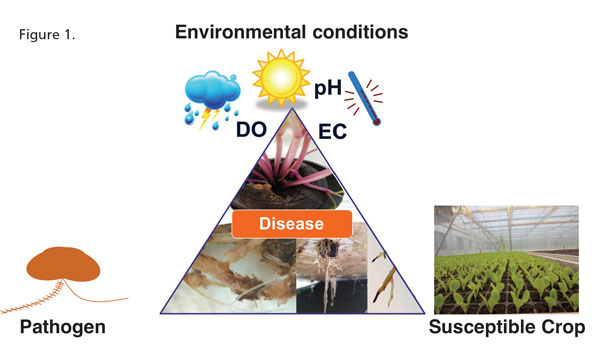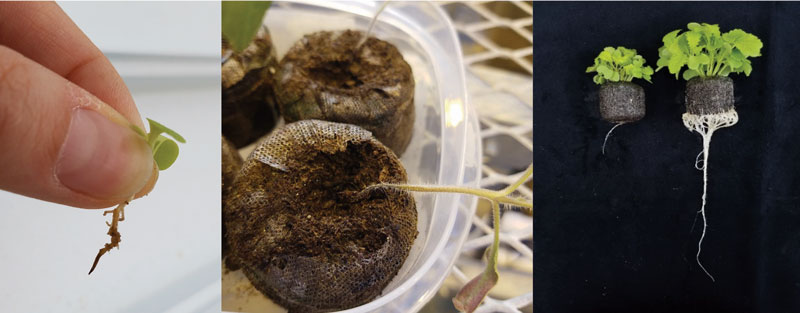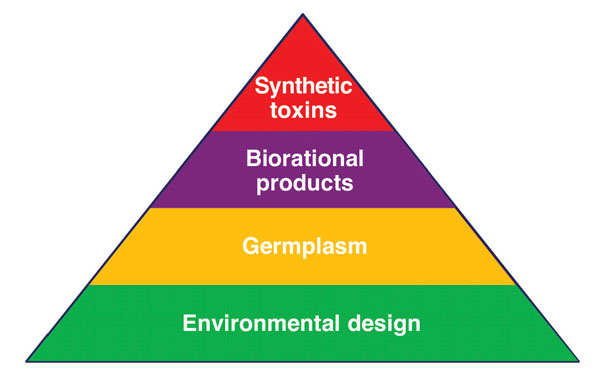2/1/2020
The Trigonometry of Root Rot Diseases
Rosa E. Raudales

All plant diseases develop in the presence of a susceptible host, a virulent pathogen and environmental conditions that favor the disease—this concept is known as the Disease Triangle (Figure 1). These three factors must be present simultaneously over time for disease to occur.
It’s useful and important to keep in mind the disease triangle when developing an integrated disease management approach.
Figure 1.
The symptoms of damping-off and root rot may include empty cells in trays where seeds were sown (AKA pre-emergent damping-off), sunken water-soaked media or dark stem lesions followed by wilted shoots, root tip necrosis (which may progress to overall rotten dark roots), and reduction in root mass (Figure 2). The disease presents over-ground symptoms such as stunting, yellowing and wilting. In some instances, the symptoms aren’t always evident and the loss in biomass may not be clear unless we compare it to healthy plants and roots. Therefore, growers should constantly inspect roots and be familiar with the expected size and coloration of roots and shoots for a given crop and stage.
The Disease Triangle
Susceptible host: We should assume that all crops are susceptible to a certain type of root (or crown) rot. Public and private institutions put a lot of effort into developing cultivars that are tolerant or resistant to diseases. However, the endeavor is lengthy, difficult and expensive. Root rot isn’t a devastating problem in container-grown ornamentals, as other diseases like Downy Mildew in impatiens and basil that threaten the commercial cultivation of these crops. In other words, root rot is ubiquitous, but manageable. Hence, we have no access to such genetics. While all production stages are susceptible to root rot, seedlings are particularly susceptible.
Management hint: If available, we would use resistant cultivars. Since that’s not an option, let us focus on the other two components of the disease triangle.
Causal agents: Water molds (Pythium or Phytophthora) and fungi (Fusarium, Rhizoctonia, Sclerotinia, Thielaviopsis, Cylindrocladium) are the common causes of seedling-damping off, and root and crown rot in ornamentals. Proper identification of the organism causing the disease is an important step in selecting the proper products to target the organisms and preventing future outbreaks. Be aware of potential common diseases by crop and send symptomatic samples to your trusted diagnostic clinician.
Management hint: Proactively identify potential points of entry or spread of pathogens and implement preventative options. If the disease has developed, prevent further spread of pathogens, identify the causal agent and then implement preventative and curative options.
Sanitation is the key for success to prevent root pathogens from entering or spreading in the system. Plug growers can use biofungicides, like RootShield Plus, which provides excellent protection against Pythium, to protect young seedlings. Growers who purchase plugs and liners from other operations should always inspect the roots and reject any trays with necrotic roots.
 Figure 2. The symptoms of damping-off and root rot may include root tip necrosis (which may progress to overall rotten dark roots), sunken water-soaked media followed by wilted shoots and reduction in root mass.
Figure 2. The symptoms of damping-off and root rot may include root tip necrosis (which may progress to overall rotten dark roots), sunken water-soaked media followed by wilted shoots and reduction in root mass.
Root pathogens are soilborne. Avoid reusing media in susceptible crops or stages. If you reuse media, make sure to pasteurize it (180F/82C for 30 minutes) before using. If you reuse trays, remove all the soil and plant debris, and then sanitize with a solution (e.g., 10% by volume chlorine).
Root pathogens can also be waterborne. Water molds like Pythium and Phytophthora have structures that move freely in the water. Organic debris in the water carries water molds and fungal pathogens. Therefore, water treatment is another method to prevent entrance and spread of pathogens.
Water sources differ in quality. Deep wells, drinking water from treatment facilities and rainwater tend to be plant-pathogen free. In contrast, surface water sources like catchment ponds and rivers is where the most abundance and diversity of pathogens have been reported, therefore, treatment of water from these sources is necessary to reduce the risk.
Regardless of the water source, water can carry organic debris via splashing or sub-irrigation and spread pathogens. To prevent this, surfaces should be debris-free and water should be treated with an injectable sanitizer with residual activity (e.g., chlorine, activated peroxygens).
Fungicides are an alternative to reduce the inoculum. In the January 2020 issue of GrowerTalks, Ann Chase discussed diseases in propagation and recommended, “Do not use fungicides preventatively on everything—a few other products have been found to delay and even stop rooting on some crops. These include products with fludioxonil or triflumizole. It’s also common to see copper used under conditions where it won’t dry quickly (like propagation). The end result is sometimes phytotoxicity that may not be apparent to the naked eye.” In other words, fungicides are one of your many tools in your toolbox, but don’t overuse them.
Environmental conditions: Greenhouse growers are well aware that wet containers or high electrical conductivity in the substrate equate to rotten roots. A factor that plays a major role in the disease development is the three factors needed to interact over a period of time. In other words, watering the plants won’t result in root rot, but maintaining the substrate wet for a prolonged period will result in disease. This partly explains why root rot tends to be common in propagation when there’s high moisture and its incidence reduces as the crop moves to further production stages. Temperature also plays a role in which pathogens flourish by season.
Management hint: Avoid overwatering and over-fertilizing. In Ann Chase’s words, “water trumps fungicides!”
My plant pathology advisor Brian McSpadden-Gardener developed a triangle to help growers understand integrated disease control, which helps explain where to start and how to progress in the decision process of disease (and pest) control (Figure 3).
The instructions are simple: start with a strong foundation by designing a system where the environment is not conducive to disease (e.g., good drainage, good aeration, temperature control, etc.). Greenhouses have a great advantage in this sense, but it only works if the system is well thought out ahead of time.
 Figure 3. Integrated disease management model (adapted from McSpadden-Gardener).
Figure 3. Integrated disease management model (adapted from McSpadden-Gardener).
The second layer of protection is to use resistant cultivars when available, then use biorational products—any products that will protect your crop from diseases, come from “natural” sources and don’t result in fungicide resistance.
Finally, as the last resort use synthetic chemistries—the reason to leave this as a last option is to prevent the development of resistance to fungicides and to reduce the exposure of workers to potential health hazards.
In short, all the tools that will interfere with the disease triangle are valid and should be in your toolbox. Use them wisely! GT
This work is supported by the Founda-tional and Applied Science Program (Critical Agricultural Research and Extension grant number GRANT
11947449) from the USDA National Institute of Food and Agriculture.
Rosa Raudales (rosa.raudales@uconn.edu) is an Assistant Professor at the University of Connecticut with an M.S. in Plant Pathology and a Ph.D. in Horticulture.